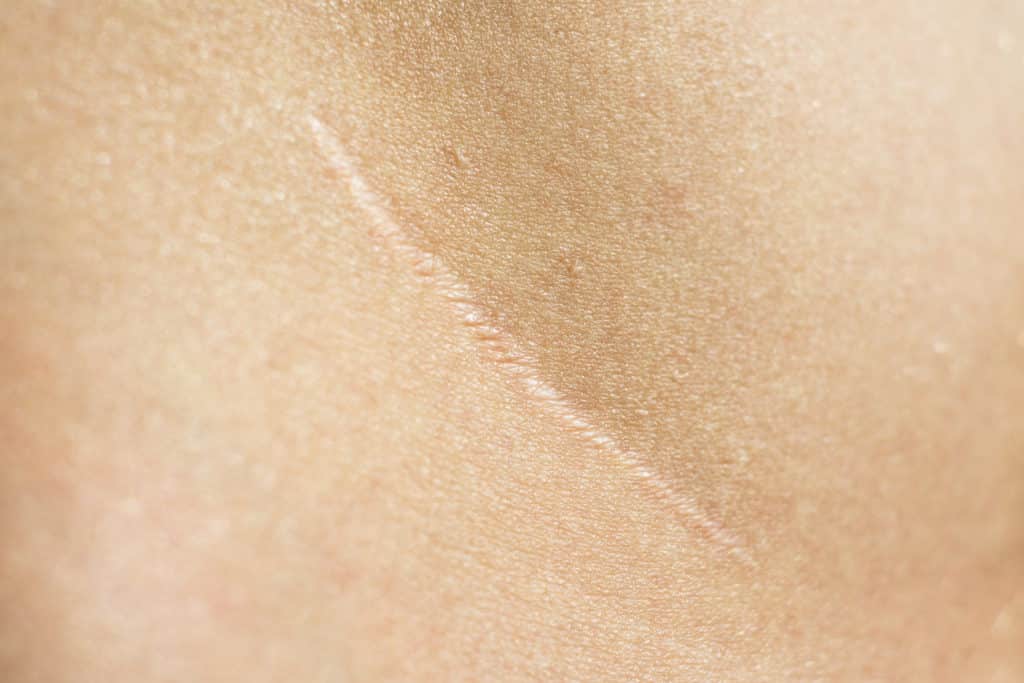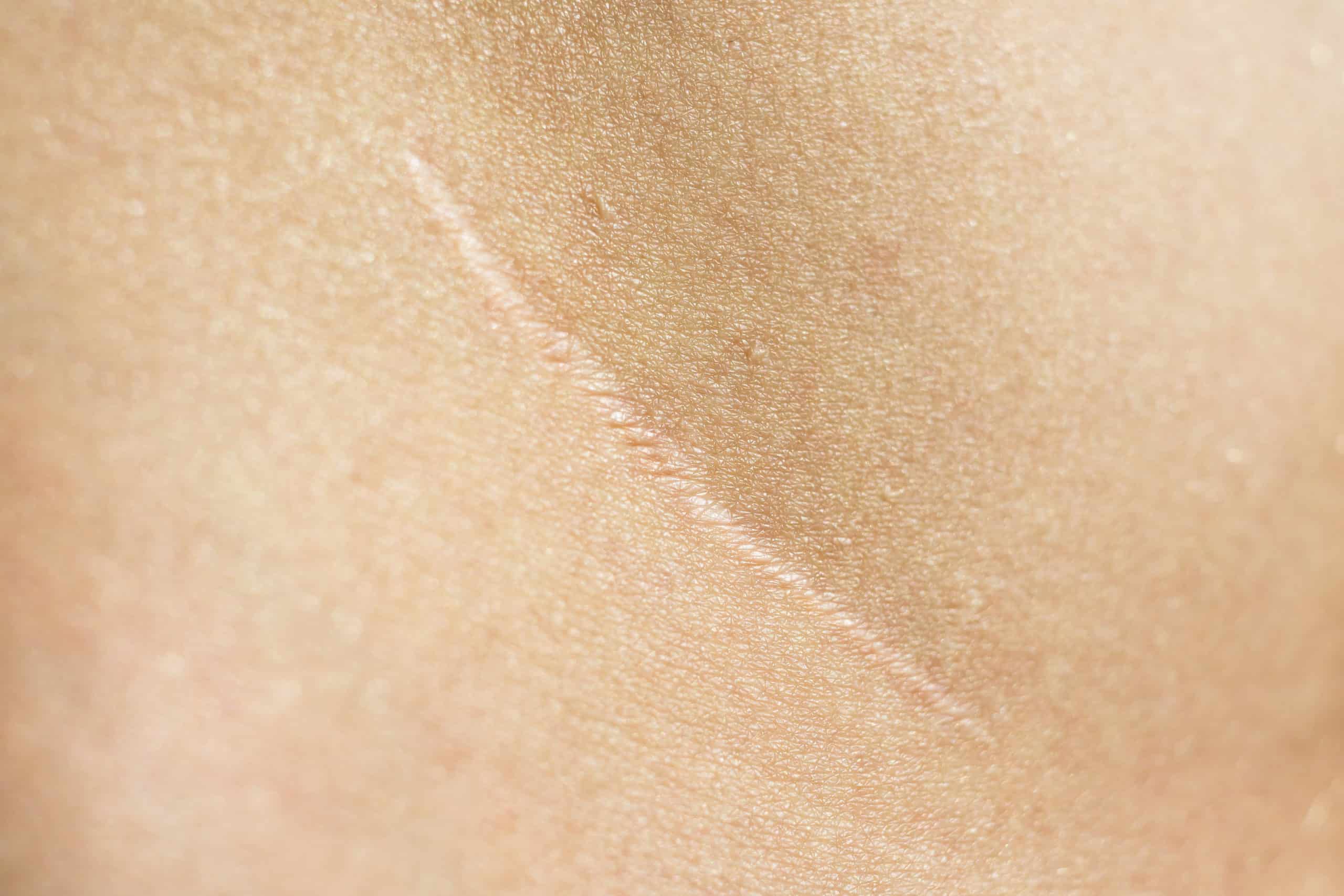Scars form as injured skin heals. For head and neck cancer patients, the most common cause of scars is surgery but they can also arise due to the effects of radiation therapy. Head and neck cancer patients who undergo surgery have scars of varying degrees.
Techniques to Reduce the Prominence of Scars
Many methods are used during surgery to minimize the appearance of future scars.
The Position of the Incisions
When possible, the surgeon can make surgical incisions in the natural creases or folds of the skin to help camouflage the scar.
Incisions & Skin Tension
Skin has elastic characteristics with areas of high skin tension. Incisions made in skin with high tension will result in more apparent scars. To avoid this, a surgeon can typically make surgical incisions in areas with minimal tension to decrease scarring.
Wound Closure Techniques
To reduce the appearance of scars, surgeons will carefully align the edges of the incision as well as use fine sutures and suture needles. In addition, the best healing occurs when the edges of the skin can close with minimal tension. This may occur when the surgeon brings together the deeper layers of the wound using absorbable sutures.
When to Remove Skin Sutures
Approximately 5–14 days after the operation, your surgeon may remove non-absorbable sutures (nylon sutures) and replace them with skin tape. The skin tape will help reduce the tension of the wound and allow for the scar tissue to remodel and strengthen as it heals.
In general, the earlier the sutures are removed, the less likely they are to leave permanent marks in the skin. A number of factors can affect the timing of suture removal. For instance, the degree of tension on the wound closure, the exposure to prior radiation, the location of the scar in the body, as well as others.
The Biology of Wound Healing
Once skin has been damaged, it is reformed and remodeled into scar tissue. When a wound heals, scar tissue will develop in the affected area as part of the body’s natural healing process. Scar tissue production typically begins around 2 to 3 weeks after initial injury and scar tissue remodeling generally takes place about 4 to 8 weeks after initial injury. During this time, the initial wound shrinks and the new scar tissue gains strength. However, depending on the size and severity of the wound, complete scar formation may take up to 6 months.
Signs of Scarring
The scarring process begins after the wound starts to heal. A few signs of the scarring process include:
- A raised area of skin
- Redness
- Scabbing
- Itchiness
- Tenderness
- Restricted movement at scar site
Scar tissue has a different composition than normal skin. As a result, scar tissue looks and behaves differently than healthy skin. For instance, scar tissue is less elastic, more sensitive to UV radiation, and does not have sweat glands or hair follicles. There are also different types of scars that a head and neck cancer patient may experience, as scarring is largely dependent on an individual’s skin type and the specific procedure they undergo.
3 Types of Scars
- Atrophic scars appear sunken into the skin. These scars often show up in the head and neck region, and tend to worsen with age. Atrophic scars typically form when skin cannot properly regenerate tissue, resulting in a scar that sits in a plane below the surrounding skin. Procedures such as mole removal and mohs surgery, a technique that involves removing layers of cancer-containing skin until only healthy tissue remains, may cause atrophic scars because they often create indents in the skin.
- Hypertrophic scars are firm, raised scars that may slowly flatten and become paler over time. These scars occur when the healing tissue generates excessive amounts of collagen—a protein that makes up part of the skin. Hypertrophic scars typically occur in regions with high skin tension, such as the chest, back of the neck, and shoulders.
- Keloid scars are also raised scars, but unlike hypertrophic scars, they often extend beyond the size of the initial wound. They appear as firm, lumpy nodules most commonly found on the cheeks, ears, or back of the neck. People with darker skin, such as Hispanics, Asians, and African Americans, may develop keloids more readily. Infection or repeated trauma at the wound site may result in a keloid scar. Keloids can continue to grow after the wound has healed, and can also begin to develop months after the initial skin injury.
Wound Care to Minimize the Appearance of Scars
Proper wound care is critical to minimize scars. While scars are permanent, they continue to change over the recovery period, which may last up to 6 months, and may fade or flatten within a couple of years. Read more about wound care.
5 Ways to Minimize Scars
Although scars are an inevitable side effect of cancer treatment, many measures can be taken to minimize the appearance of scars. The primary goal of scar management is to reduce the severity of the scar. Some ways to minimize scarring include:
- Practice proper wound care.
- Massage the scar to soften and flatten scar tissue.
- Avoid UV exposure to prevent sunburns. Always use sunscreen or sun protective clothing when outside to protect your scars from reddening, particularly during the first 6 months of healing.
- Moisturize the scar. This may involve using creams or silicone sheets on the scar and surrounding skin. These topical treatments provide a protective layer of moisture over the scar to prevent skin dryness and reduce itchiness.
Several products may be used to moisturize the scar, such as Mederma Scar Gel, Aquaphor, Derma E Scar Gel, Puriderma Scar Removal Cream, ScarAway Silicone Scar Sheets, and Cica-Care Gel Sheets - Steroid injections may reduce scar inflammation. Your doctor will decide if and when they may be necessary. This treatment is typically used for management of hypertrophic scars and keloids.

Conclusion
Managing and minimizing scars after head and neck cancer treatment requires a comprehensive approach that includes understanding the biology of wound healing, utilizing surgical techniques to reduce scar visibility, and employing effective post-surgical wound care. Various types of scars, such as atrophic, hypertrophic, and keloid scars, each require specific management strategies to ensure the best cosmetic outcome. By following best practices for wound care, employing the use of silicone sheets, gels, and possibly steroid injections, patients can significantly improve the appearance of scars. This holistic approach to scar management not only aids in physical healing but also supports the emotional and psychological well-being of cancer survivors.












